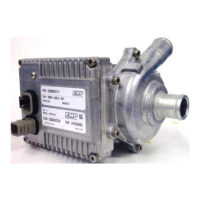Physical Inspection
9970002273, REV A, 21NOV12 © 2012 EMP Advanced Products 19
Physical Inspection
CAUTION: DO NOT RUN THE PUMP WITHOUT FLUID PRESENT. IF RUN DRY EVEN FOR A SHORT
PERIOD THE SEAL WILL BE DAMAGED.
1. Make sure the weep hole ports are not clogged with debris. If weep holes are plugged then
open them up.
Weep Hole Ports
2. While the pump is connected to the bus, remove the 6 pin plug and connect the TTL adapter
and turn the bus and heating switches "on" (to enable pump).
a. 24V power and IGN must be supplied to pump or it will not connect to the service tool.
b. Use EMPower Connect™ Service Tool to verify that the pump is on and running at
correct speed.
3. Evaluate the pump for abnormal noises during operation. This is a subjective evaluation,
vibration is not grinding; the user is looking for a noticeable bearing noise.
4. Observe the pump and area for leaking coolant. Fluid pouring out of the weep hole would
indicate a failed mechanical seal. Dampness around the weep pocket is acceptable.
NOTE:
COOLANT MAY BE SEEN OUTSIDE THE EMP WP29 ELECTRIC WATER PUMP. Mechanical Seal
design requires fluid between the shaft and the seal material. This fluid vaporizes and passes the
seal, venting through the weep collection pocket. As the seal wears in, the amount of venting
decreases but never to zero.
In properly oriented pumps, the vapor will harmlessly evaporate unless the outside surfaces are
cool enough to condense the vapors, which may result in a small volume of coolant visible on the
exterior of the weep holes
There are two weep holes that vent from the same cavity. One will be capped with a solid plug,
the other with a cap with two holes. If the pump seals are leaking excessively, fluid will come
through the holes.
Acceptable Leakage
Depending on pump installation orientation, pumps may show up to 10 cc external leakage during
the first 100 hours. In the preferred orientation, about half this amount may have external leakage.
10 cc coolant will make a small puddle approximately 4 inches across on a flat surface.

